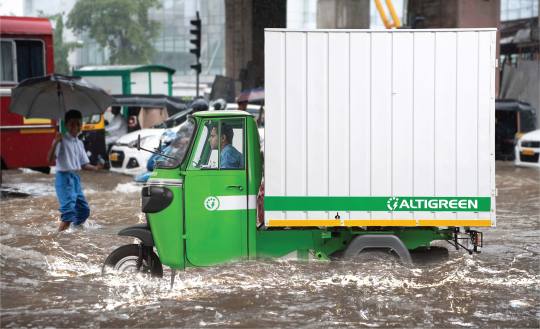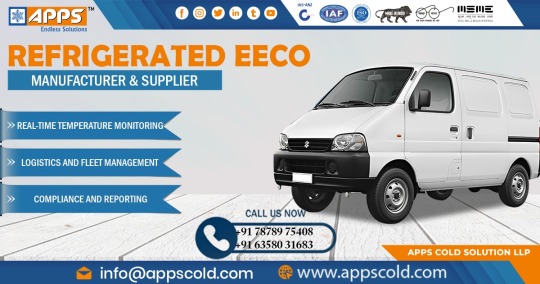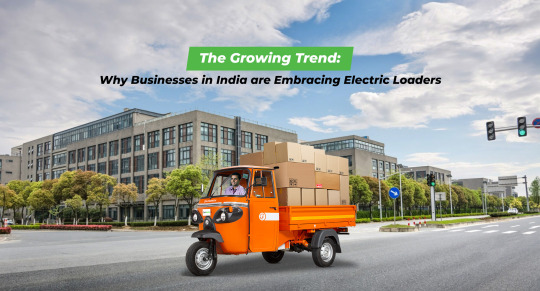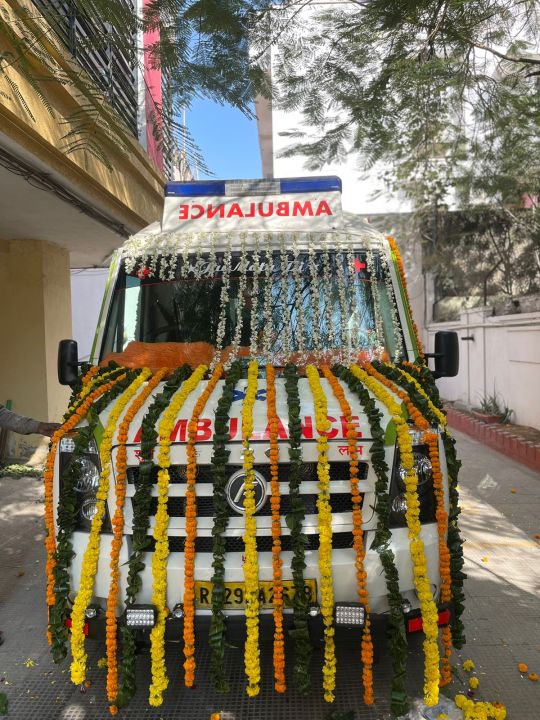#electric cargo vehicles in india
Text

What Model to Choose for EV Cargo in India
EVs are growing in popularity in India. The total number of electric vehicles on Indian roads is expected to touch 5 crores by 2030. The electric 3-wheeler segment alone is likely to grow by 90-95% by 2030
#Altigreen#electric cargo vehicle in india#electric cargo vehicles in india#best electric auto rickshaw in india#electric 3 wheeler
0 notes
Text

E Rickshaw Loader: Affordable and Efficient Solutions
Looking for an eco-friendly and cost-effective transportation solution? The e rickshaw loader is the answer. These versatile vehicles have revolutionized urban logistics with their affordability and efficiency. Understanding the e rickshaw loader price is crucial for businesses and individuals seeking to invest in this sustainable technology.
The e rickshaw loader price varies depending on several factors, including the features and battery capacity. Basic models are more affordable, while premium versions with extended battery life and advanced features might cost more. Despite the initial investment, the low running and maintenance costs make e rickshaw loaders a smart choice.
Additionally, government incentives and subsidies for electric vehicles can significantly reduce the e rickshaw loader price, making them even more accessible. These incentives aim to promote green transportation and reduce urban pollution, aligning with global sustainability goals.
Investing in an e rickshaw loader not only supports environmental conservation but also offers practical benefits like reduced fuel costs and lower maintenance expenses. As cities continue to embrace green technology, the demand for e rickshaw loaders is expected to rise, making now the perfect time to understand and leverage the best e rickshaw loader options.
#E Rickshaw Loader#E Rickshaw Loader Price#E Rickshaw Price in India#Electric Rickshaw Loader#Eco-friendly Transportation India#Affordable E Rickshaw#E Rickshaw Subsidies India#Green Transportation India#Urban Logistics Solutions#Cost-effective E Rickshaw#Low Maintenance E Rickshaw#Electric Vehicle Incentives India#Sustainable Transport India#E Rickshaw Battery Capacity#Urban Pollution Reduction#Electric Cargo Vehicles India#Indian E Rickshaw Market#E Rickshaw Loader Investment#Government Subsidies Electric Vehicles#Green Technology India
2 notes
·
View notes
Text
Big Oil faces a tiny foe on the streets of Asia and Africa. The noisy, noxious vehicles that run on two and three wheels, carrying billions of people daily, are quietly going electric — in turn knocking down oil demand by one million barrels a day this year. ...
The global majority doesn’t roll on four wheels.
In Nairobi and Hanoi, motorcycles serve as taxis. In Mumbai, scooters can carry a family of four. In China, electric bicycles are how millions commute.
“Electric bikes are quieter, much more efficient and good for the environment,” said Jesse Forrester, the founder of Mazi Mobility, which has 60 electric motorcycle taxis, known as boda-bodas, on the roads in Nairobi. “There’s a quiet revolution now in Kenya driving this transformation for the future.” ....
In Darbhanga, a new acid-battery rickshaw, like the one Mr. Rai drives, sells for around 175,000 rupees, or $2,100. That’s half the price of a new rickshaw powered by natural gas. Charging the battery costs 20 rupees (25 cents), one-fourth of the price of filling a gas tank.
The rebates seem to be working. Reliance Industries, India’s biggest company, is converting its three-wheeled cargo vehicles from gas to electric. Food delivery services are going electric as quickly as possible.
No paywall: https://web.archive.org/web/20231209105128/https://www.nytimes.com/2023/12/09/business/energy-environment/two-three-wheel-electric-vehicles.html
23 notes
·
View notes
Text
2023 Wrapped: Here Are Top 10 Logistics Trends That Defined The Year
2023 has been a year of new beginnings for the Indian logistics industry. It is the year logistics companies bounced back from the post-pandemic slump and set out to recover from their losses. The year also witnessed a steady growth in eCommerce, with the spotlight on quick commerce and last mile logistics. The later part of 2023 saw the government extending generous support to digital commerce and logistics, through initiatives like Open Network for Digital Commerce (ONDC) and National Logistics Policy (NLP).
Looking back, we can confidently assert that 2023 has been a good year for India’s logistics sector. From the increased focus on supply chain sustainability to extensive experimentation with drone deliveries, here are the top trends that defined logistics this year.
1. Greener transportation and supply chain
The amount of greenhouse gases generated by India’s transportation sector has nearly tripled since the 1990s, accounting for over 14% of our total energy emissions. The problem is quite severe if we take into account the massive carbon footprint left by India’s booming supply chain.
In 2022, there was a rise in awareness around cleaner and greener logistics practices, with a nudge on electrifying India’s cargo transportation. Logistics and transportation startups unveiled their fleet of electric (EV) and clean energy vehicles. At Blowhorn, we converted 30% of our fleet to clean fuels and took the pledge of running 100% of our fleet on clean energy by 2025.
In addition, other green practices like solar-powered warehousing, eco-friendly packaging and paperless invoicing were also adopted widely.
2. Third party logistics
The concept of third-party logistics (3PL) took off in India only a few years back. In 2022, India’s 3PL market reached a staggering $58.4 Bn in valuation, with a projected annual growth of 7.42%.By 2027, the market is estimated to reach more than $83.53 Bn.
The 3PL market is primarily driven by manufacturing, FMCG, retail and eCommerce sectors — all of which experienced commendable growth this year. Keeping in mind the needs of the modern Indian entrepreneur, 3PL service providers are also improving their operational speed with the incorporation of technology.
In the coming days, development of infrastructures like logistics parks, dedicated freight corridors, free trade warehousing zones, and container freight stations are expected to improve the efficiency of the Indian 3PL market.
3. Higher investment in technology
With higher investment technology seeping into eCommerce, retail, education, hospitality, finance, and all other sectors, why should logistics be left behind? With increasing market demand for superfast delivery, Indian logistics startups invested more on modern technology to boost their operations.
Experts believe that India is headed towards a technological revolution in logistics. Tech like Artificial Intelligence (AI), Machine Learning (ML), Internet of Things (IoT) are optimally benefitting the supply chain in terms of seamless management, improved route planning, warehouse automation, digital payments and much more.
At Blowhorn, we are already speeding up our deliveries with AI-powered route optimization software. Our automated warehouse management system helps in seamless handling of stored inventory and order dispatch, while we offer a real-time tracking system for all our orders. We have also adopted novel technologies like geo-fencing to reduce the menace of fake delivery attempts.
4. LaaS (Logistics as a Service)
We are well-acquainted with Software as a Service (SaaS) companies. This year saw the emergence of companies following a similar model in fulfillment, offering Logistics as a Service (LaaS). Ideally, this presents a plug and play model for your business’s logistics needs, which you can avail via a simple integration with your 3PL partner.
Blowhorn has set the ball rolling for LaaS in India, offering end-to-end logistics solutions with warehousing, transportation and hyperlocal delivery.
5. Greater supply chain transparency
With rising consumer concerns, logistics stakeholders worked towards improving supply chain visibility and transparency in 2023. Companies are striving to become more transparent with regards to the sustainability of their supply chains. Globally, 2023 saw more companies offering insights on their labor practices, job creation, sourcing methods and compliance with regulatory requirements — in a bid to enhance their brand image among the conscious modern consumer.
6. Blockchain in last mile logistics
While AI is helping to improve speed and efficiency, blockchain has been deemed as a viable solution for more transparency and visibility in last mile logistics. In India and abroad, companies have started incorporating blockchain to optimize the last mile deliveries. The technology has found best use in high value inventory tracking, secure invoicing and payments, fraud detection, improved supply chain transparency, dispute resolution and creating a fair freight marketplace.
With the launch of Open Network for Digital Commerce (ONDC) by the Indian government, there is hope that we will witness further adoption of blockchain in the digital commerce and logistics space. In fact, ONDC itself is a blockchain-based protocol which aims to create a fair and transparent marketplace for small and medium-sized businesses across India. With Blowhorn being one of the early participants of ONDC, we too are waiting and watching the best use case for blockchain in our fulfillment services in the near future to help our customers.
7. Micro-fulfillment > Traditional Warehousing
2022 saw a rise in demand for same day delivery, which is quite difficult to fulfill if your inventory is stocked in a warehouse far away from the customer's location. The longer the delivery distance, the more the delivery time — a simple thumb rule to keep in mind.
This is why top in 2023 opted for micro ecommerce-fulfillment centers or micro-warehouses. The concept of micro-warehousing follows a just-in-time inventory management approach, with goods never staying here for more than a day. The limited inventory is stocked in a network of collocated storehouses at high-demand pincodes. Not only does the process help in reducing a brand’s capital spend on inventory, but it also improves efficiency and decreases resource wastage.
Much before the pandemic, we launched India’s first micro-warehouses or micro-fulfillment centers as an experiment in 2018. Now we maintain an expansive network of micro-warehouses across 28 cities of India. Read this article to find out why more eCommerce startups are choosing micro-fulfillment in 2023-24.
8. Automation in shipping
When it comes to automation in shipping, the process works on a predefined pathway involving packaging, warehousing, material handling and security. In India, the adoption of automation in logistics and shipping has been steadily increasing since the pandemic.
In 2023, 3PL fulfillment companies like Blowhorn incorporated automated solutions to boost efficiency by** reducing overhead costs** and time, streamlining the supply chain and minimizing the chances of manual errors.
9. Extensive focus on hyperlocal logistics
2023 saw a high growth in the hyperlocal space with the emergence of newer players in the quick commerce sector. Meanwhile, eCommerce giants and existing logistics players focused more on faster deliveries to not miss out on their customer needs.
Improved internet penetration led to the growth of fast fulfillment in suburbs and rural belts, thus creating a need for hyperlocal elements like dark stores, micro-ecommerce fulfillment centers along with local delivery jobs.
At Blowhorn, we have developed a platform-agnostic technology to be able to integrate with a wide range of businesses ranging from D2C, marketplaces and omni channel players. Our hyperlocal strategy is defined by AI-based dynamic route planning, real-time order clubbing, automated warehousing, blockchain and even drone deliveries. We are aiming to build a sustainable hyperlocal delivery system to tackle small profit margins, high overhead costs and ever-evolving consumer expectations.
10. Experimentation with Drone Deliveries
Delivery by drones is not new. The idea has been widely explored by logistics providers across India but is yet to be adopted at scale. The idea of mapping a three-dimensional delivery route via drones holds immense potential and has excited the Indian government authorities as well. Jyotiraditya Scindia, the Union Minister for Civil Aviation, has stated the administration’s objective to turn India into a major drone hub by 2030.
Leading logistics players like Blowhorn and others are already chalking out the blueprint to make drone delivery an everyday reality. Gartner predicts that by 2026, more than one million drones will be carrying out retail deliveries, up from 20,000 today. Last year, the Indian government also released the draft of The Drone Rules, 2021, aiming to liberalize drone delivery while fulfilling the safety regulations. Autonomous last-mile delivery via these mini flying machines will significantly determine the growth trajectory of Indian logistics in the upcoming future.
2 notes
·
View notes
Text
Supplier of Refrigerated Eeco in Rajasthan

Company Overview:
Apps Cold Solutions is a Supplier of Refrigerated Eeco in Rajasthan, India.
We are a Refrigerated Eeco manufacturer in Ahmedabad, Gujarat, India.
The company offers a diverse range of solutions including refrigerated containers, insulated shipping containers, blast freezers, cold rooms, storage units, multi chambers, ripening chambers, incubation chambers, and doors/accessories.
Apps Cold Solutions prioritizes quality, ensuring that each product meets rigorous standards to provide reliable and efficient refrigeration solutions for customers.
Key Features:
Efficient Cooling: Maintains low temperatures, preserving perishable goods during transport.
Energy Efficiency: Uses electric components, reducing fossil fuel use and environmental impact.
Compact Design: Fits within tight spaces in vehicles and containers to maximize cargo capacity.
Temperature Control: Advanced systems ensure precise temperature settings for various goods.
Reliability: Durable materials and construction withstand transportation rigors and diverse environments.
Specifications:
System Type: Combines electric refrigeration and evaporative cooling for effectiveness.
Cooling Capacity: Offers multiple capacities to suit various cargo sizes and needs.
Temperature Range: Maintains temperatures from -20°C to +10°C (-4°F to +50°F).
Power Source: Operates on the vehicle’s electrical system or an external source for operational flexibility.
Control System: Features user-friendly panels for easy monitoring and temperature adjustments.
Apps Cold Solutions is a Supplier of Refrigerated Eeco in Rajasthan Including Ajmer, Alwar, Anupgarh, Balotra, Banswara, Baran, Barmer, Beaware, Bharatpur, Bhilwara, Bikaner, Bundi, Chittorgarh, Churu, Dausa, Deeg, Dholpur, Didwalna-Kuchaman, Dudu, Dungarpur, Ganganagar, Gangapur City, Hanumangarh, Jaipur, Jaipur, Jaisalmer, Jalore, Jhalawa, Jhunjhunu, Jodhpur, Jodhpur, Karauli, Kekri, Kherthal-Tijara, Kota, Kotputli-Behror, Nagaur, Pali, Phalodi, Pratapgarh, Rajsamand, Salumbar, Sanchore, Sawai Madhopur, Shahpura, Sikar, Sirohi, Tonk, Udaipur.
For further details and inquiries, interested parties can contact Apps Cold Solutions.
Read the full article
0 notes
Text

The Growing Trend: Why Businesses in India are Embracing Electric Loaders
One of the key reasons businesses are opting for electric loaders is the potential for significant cost savings, sufficient range and improved operational efficiency. Electric vehicles, such as Altigreen's electric cargo vehicles, have lower operating costs compared to conventional diesel or petrol powered vehicles. With reduced fuel expenses and minimal maintenance requirements, businesses can experience a noticeable reduction in overall operational expenditures.
0 notes
Text
Upcoming Electric Car Toyota bZ4x in India 2024 – Features, Specs & More

Expected to grace the Indian automotive scene by mid-2024, the Toyota bZ4X EV is poised to make a grand entrance, heralding Toyota’s significant leap into the electric vehicle domain. Developed in collaboration with Subaru, the bZ4X, also known as Solterra, is set to captivate the market with its estimated price tag of Rs. 27 Lakh and a promise of nationwide availability.
Let’s delve into the specifics of this forthcoming electric marvel.
EV Motor, Power, and Performance: The bZ4X offers two powertrain options to cater to varied driving preferences. The front-wheel-drive model boasts 201 horsepower, while the all-wheel-drive version ups the ante with 215 horsepower. Initial test drives have showcased perky acceleration, coupled with commendable ride quality and responsive steering.
Range, Charging & Battery Life: Equipped with either a 63.4-kWh or 65.5-kWh battery pack, the bZ4X promises a range of up to 252 miles (Limited/XLE) for the front-wheel-drive variant and 228 miles for the all-wheel-drive version. Charging is facilitated by a 6.6-kW onboard charger, enabling an 80 percent charge in under an hour at a DC fast-charger.
Fuel Economy: Efficiency ratings for the bZ4X are impressive, with city ratings as high as 131 MPGe. Real-world testing, however, revealed a slightly lower highway rating of 86 MPGe for the dual-motor Limited model.
Interior, Comfort & Cargo: Inside, the bZ4X offers a spacious environment with a digital gauge display, a 12.3-inch central touchscreen, wireless smartphone charging, and ample storage space. The rear cargo hold provides 26 to 28 cubic feet of space.
Infotainment and Connectivity: All models feature a 12.3-inch infotainment touchscreen with wireless Android Auto & Apple CarPlay, cloud-based navigation, and onboard Wi-Fi. Optional upgrades include a nine-speaker JBL stereo system.
Safety and Driver-Assistance Features: Standard safety features include adaptive cruise control, pedestrian detection, automated emergency braking, and lane-keeping assist, aligning with Toyota’s commitment to driver safety.
Conclusion: As the automotive industry embraces electrification, the Toyota bZ4X emerges as a compelling option, blending comfort, technology, and safety. Despite some limitations in power and range, its imminent arrival signals Toyota’s dedication to sustainable mobility solutions in the evolving electric vehicle market of 2024.
Also Read
Know All About Tata Curvv EV – Price, Features, Launch Date & More
0 notes
Text
Electric vehicles, or EVs, are changing the roads.
These eco-friendly rides run on electric motors and come in many forms, from two-wheeled scooters to zippy cars. They're a great way to cut down on emissions and fuel costs.
Electric two-wheelers: From popular electric scooters that zip through city streets to e-bikes, these are a cost-effective and eco-friendly alternative to traditional fuel-powered options. The e-bike market itself is expected to reach a whopping USD 34.80 billion by 2024, highlighting its explosive growth! Electric bikes marketin India Is Most Popular EV .The electric bicycle market in india: A Promising Ride Ahead The Indian electric bicycle market is witnessing exciting growth. Factors like rising fuel prices, government incentives, and growing environmental consciousness are fueling this trend.
Electric three-wheelers: These are perfect for short-distance passenger and cargo transportation, offering a cleaner alternative to rickshaws and small commercial vehicles.
Electric cars: While still a developing segment, electric cars are gaining traction with rising awareness and government incentives.
Electric buses: Public transport is getting a green makeover with electric buses offering a quieter and more sustainable way to travel in cities.
0 notes
Text
Marine Cranes Market 2024 Growth, Trends, Leading Players And Business Insights Forecast To 2033
Marine cranes are large, specialized cranes used for loading and unloading ships. They are used for a variety of tasks, including lifting heavy cargo, moving containers on and off ships, and loading and unloading vehicles from ships. Marine cranes come in a variety of sizes and designs, and can be either fixed or mobile.
Fixed marine cranes are typically used for loading and unloading ships that are docked at a pier or other stationary platform. These cranes are typically very large and can be operated manually or by hydraulic or electric power. Mobile marine cranes are used for loading and unloading ships that are not docked, such as those at anchor or at sea. These cranes are typically smaller than fixed cranes and are mounted on barges or other floating platforms.
To Know More: https://www.globalinsightservices.com/reports/marine-cranes-market/?utm_id=Snehalkast
Market Outlook
The key trends in marine cranes technology are:
1. The development of new materials and technologies that can withstand the harsh marine environment.
2. The development of new designs that are more efficient and have a smaller environmental footprint.
3. The development of new construction methods that are faster and more cost-effective.
4. The development of new safety features that can prevent accidents and injuries.
The key drivers of the marine cranes market are the increased demand for maritime transportation, the need for efficient and safe handling of cargo, and the need for better and more efficient maritime infrastructure. The maritime transportation industry has been growing steadily over the past few years, and this has led to an increased demand for marine cranes. Marine cranes are used for a variety of purposes, including loading and unloading of cargo, lifting and moving heavy objects, and construction and maintenance of maritime infrastructure.
Request Sample: https://www.globalinsightservices.com/request-sample/GIS22964/?utm_id=Snehalkast
Major Players
The key market players in the Marine Cranes Market are Techcrane International (US), Anupam Industries Limited (India), PALFINGER AG (Austria), DMW Marine Group, LLC (Mexico), HS MARINE S.R.L. (US), Kenz Figee Group (Netherlands), HEILA Cranes S.p.a. (US), Fjell Marine Service AS (Norway), Gulf Crane Service (US), and NINGENMURA COMPANY (Japan).
0 notes
Text
Powering Progress: Insights into the India Electric 2W and 3W Vehicle Market
In the landscape of sustainable mobility, electric two-wheelers (2Ws) and three-wheelers (3Ws) are emerging as key players in driving progress towards cleaner and more efficient transportation solutions. In India, a country grappling with rising pollution levels and urban congestion, the electric 2W and 3W vehicle market holds immense potential to transform the way people commute and transport goods. Understanding the dynamics, trends, and challenges of this market provides valuable insights into the future of mobility in India and beyond.
At the core of the India electric 2W and 3W vehicle market lies the imperative to reduce emissions, dependence on fossil fuels, and urban congestion. With rapid urbanization and a growing population, Indian cities are facing unprecedented challenges related to air quality, traffic congestion, and noise pollution. Electric 2Ws and 3Ws offer a sustainable and cost-effective alternative to traditional gasoline-powered vehicles, with zero tailpipe emissions and lower operating costs. As a result, government initiatives, incentives, and policies aimed at promoting electric mobility are driving the adoption of electric 2Ws and 3Ws in India.
Moreover, the India electric 2W and 3W vehicle market are driven by advancements in technology, battery innovation, and manufacturing capabilities that are making electric vehicles (EVs) more affordable, reliable, and accessible to consumers. Lithium-ion battery technology, in particular, has emerged as a game-changer in the electric vehicle industry, offering higher energy density, longer range, and faster charging times compared to traditional lead-acid batteries. Additionally, improvements in motor efficiency, power electronics, and vehicle design are enhancing the performance, safety, and reliability of electric 2Ws and 3Ws, making them more attractive to consumers.
Request the sample copy of report @ https://www.globalinsightservices.com/request-sample/GIS24653
Furthermore, the India electric 2W and 3W vehicle market are influenced by changing consumer preferences, urban mobility trends, and government regulations that are shaping the adoption and deployment of electric vehicles. As consumers become more environmentally conscious and cost-conscious, there is a growing demand for electric 2Ws and 3Ws that offer not only clean and efficient transportation but also affordability and convenience. Additionally, urban mobility trends such as ride-sharing, last-mile delivery, and micro-mobility are driving the demand for electric 2Ws and 3Ws as flexible and agile solutions for short-distance travel and cargo transportation.
Additionally, the India electric 2W and 3W vehicle market are characterized by a diverse ecosystem of players, including OEMs, startups, component suppliers, and charging infrastructure providers, all working together to drive innovation and market growth. While established OEMs are investing in electric vehicle platforms and product portfolios, startups are disrupting the market with innovative business models, lightweight designs, and connected features. Furthermore, component suppliers are collaborating with OEMs to develop advanced battery packs, motors, and power electronics tailored to the specific requirements of electric 2Ws and 3Ws. Additionally, charging infrastructure providers are expanding their networks and services to support the growing demand for electric vehicles across India.
Despite the opportunities for growth, the India electric 2W and 3W vehicle market also face challenges, including infrastructure constraints, technology adoption barriers, and market fragmentation. While the adoption of electric 2Ws and 3Ws is gaining momentum in urban centers and metro cities, rural areas and Tier-II/III cities still lack adequate charging infrastructure and awareness about electric mobility. Additionally, concerns about range anxiety, battery life, and upfront costs continue to hinder widespread adoption of electric 2Ws and 3Ws among consumers. Furthermore, market fragmentation and regulatory uncertainties pose challenges for industry stakeholders, requiring coordinated efforts and partnerships to address common challenges and accelerate the transition to electric mobility in India.
In conclusion, the India electric 2W and 3W vehicle market represent a significant opportunity to drive progress towards cleaner, greener, and more sustainable transportation solutions. With government support, technological innovation, and industry collaboration, electric 2Ws and 3Ws have the potential to transform the way people commute and transport goods in India, reducing emissions, improving air quality, and enhancing urban mobility. By understanding the dynamics, trends, and challenges of the India electric 2W and 3W vehicle market, industry stakeholders can capitalize on opportunities and overcome barriers to accelerate the adoption and deployment of electric mobility solutions in India.
0 notes
Text

Bengaluru-based electric vehicle company, determined to change the way three-wheeler electric cargo vehicles are manufactured and experienced in India. Having developed an indigenous technology after years of R&D, our two electric commercial vehicles, the High Deck and the Low Deck, are the most affordable, economical and environment friendly vehicles in the last-mile transport system in the country
Determined to change the way three-wheeler electric cargo vehicles are manufactured and experienced in India.
Having developed an indigenous technology after years of R&D, our two electric commercial vehicles, the High Deck and the Low Deck, are the most affordable, economical and environment friendly vehicles in the last-mile transport system in the country
#electric cargo vehicle in india#commercial electric vehicles in india#electric cargo vehicles in india#3 wheeler electric vehicle in india#electric goods vehicles in india#electric load vehicle in india#electric cargo vehicles#electric vehicles company in bangalore
0 notes
Text
Increasing Proliferation of Electric Rickshaws Driving Electric Rickshaw Motor and Controller Sales in India
Due to a number of growth factors, such as the increasing number of electric rickshaws on Indian roads and their surging average age and low operating cost, and government incentives and environmental policies, the Indian electric rickshaw motor and controller marketis expected to continue to witness rapid growth over this decade.
Get More Insights: https://www.psmarketresearch.com/market-analysis/india-electric-rickshaw-motor-and-controller-market

The demand for such motors and controllers in India is increasing owing to the proliferation of electric rickshaws in the nation, due to the escalating need for low-cost vehicles for first/last-mile connectivity, government support in the form of incentives, and their low operating cost. For instance, there were over 7 lakh electric rickshaws on Indian roads in 2018, which increased by about 6 lakh units from the number recorded in 2014. The sudden rise in the number occurred mainly due to the incentives and environmental policies implemented by the government.
Motors rated at 1,001–1,500 Watts of power outsell all other variants due to the existence of several local and unorganized companies providing 1,001–1,500-W electric motors in large numbers. Whereas, 1,501–2,000-W and >2,000-W motors are projected to observe a massive rise in their sales in the coming years. This would be because currently, most of the e-rickshaws are used to ferry passengers, but those used for transporting cargo are witnessing a rapid increase in sales around the country.
Battery rickshaw manufacturers, owners, and drivers generate the highest demand for motors and controllers. These rickshaws are the best substitutes for cycle rickshaws, as they do not require human power for propulsion and are relatively easy to operate. Moreover, due to their low operating and purchase costs than traditional auto rickshaws, the sale for battery rickshaws is increasing.
State-wise, Delhi registers the highest revenue from the sale of these components on account of the high sales of electric rickshaws and surging air pollution level in the state. In response to this, a subsidy of $439.6 (INR 30,000) on electric rickshaws was provided by the Delhi government in 2016. Similarly, product sales are burgeoning in Uttar Pradesh owing to the rising demand for electric rickshaws in the Tier-1 and Tier-2 cities, as well as the rural areas of the state.
However, in the past, the motors and controllers available in the country had no guarantee of quality, as they were produced by independent entities working at small factories often established inside workers’ homes. But, now, since the government implemented GST, such unorganized players have found it hard to sell their products, and they are now being overrun by established and well-known OEMs, such as Mahindra, Hero, and those based in China.
Thus, the growing adoption of electric rickshaws in India will drive the demand for motors and controllers in the foreseeable future.
#India Electric Rickshaw Motor and Controller Market Share#India Electric Rickshaw Motor and Controller Market Size#India Electric Rickshaw Motor and Controller Market Growth#India Electric Rickshaw Motor and Controller Market Applications#India Electric Rickshaw Motor and Controller Market Trends
1 note
·
View note
Text
Best Battery Operated E-Rickshaw Loader in India
Explore efficient transportation with Saera Electric Auto's battery-operated e-rickshaw loader. Combining eco-friendly technology and cargo capacity, these vehicles redefine urban logistics. Saera Electric Auto prioritizes sustainability, offering a reliable solution for businesses seeking a greener and cost-effective alternative. Embrace the future of electric mobility with Saera's innovative e-rickshaw loader, delivering convenience and environmental consciousness in every ride.
0 notes
Text
E-bikes Market To Reach $52.37 Billion By 2030 | CAGR: 14.5%
The global e-bikes market size is expected to reach USD 52.37 billion by 2030, expanding at a CAGR of 14.5% from 2023 to 2030, according to a new report by Grand View Research, Inc. Electric bikes are considered an eco-friendly and flexible mode of transportation. They are an ideal substitute for public transport, scooters, and smart cars as they help avoid traffic jams and achieve high speed with minimal effort. Moreover, they enable riders to maintain a healthy lifestyle through increased physical activity. These factors are contributing to the growth of the global market.
The declining consumer inclination toward cars owing to increased traffic on streets and growing urbanization is expected to offer lucrative growth opportunities for the market across the globe. Additionally, governments of several countries, including India, U.K., and Canada, are focused on developing infrastructures for bicycles owing to the growing consumer preferences for electric bikee-bikes. For instance, in 2017, Bikeep, a commercial bike parking systems and bike racks manufacturer, introduced a smart bicycle rack solution that offers electric bicycle charging. The solution is designed to cater to various popular electric bicycles.
Key players in the market are focused on strategies such as new product launch and geographic expansion to enhance their business operations and product offerings. For instance, in October 2020, Giant Manufacturing Co. Ltd. announced the launch of a full-composite trail bike, Trance X Advanced Pro 29. The bike is equipped with an updated Maestro rear suspension and flip-chip feature that permits riders to modify the frame geometry. Similarly, in October 2020, Pedego Electric Bikes opened a new store in Boca Raton, Florida. The store offers a full range of electric bikes for rental and sale, along with related accessories and services.
Request a free sample copy or view report summary: E-bikes Market Report
E-bikes Market Report Highlights
The pedal-assisted segment is expected to dominate the market over the forecast period owing to the rising demand for pedal-assisted e-bikes among the youth and elderly population
The lead-acid battery segment dominated the market with a 55.2% market share in 2022, owing to benefits such as low cost and robustness. However, the share is anticipated to decline as a result of a significant rise in demand for Li-ion batteries
The Asia Pacific is expected to become the largest regional market over the forecast period owing to significant investments in the vehicle charging infrastructure and government subsidies for battery-powered vehicles
E-bikes Market Segmentation
Grand View Research has segmented the global e-bikes market based on propulsion type, battery type, power, application, and region:
E-bikes Propulsion Type Outlook (Revenue, USD Million, 2018 - 2030)
Pedal-assisted
Throttle-assisted
E-bikes Battery Type Outlook (Revenue, USD Million, 2018 - 2030)
Lithium-ion Battery
Lead-acid Battery
E-bikes Power Outlook (Revenue, USD Million, 2018 - 2030)
Less than or equal to 250W
Above 250W
E-bikes Application Outlook (Revenue, USD Million, 2018 - 2030)
City/Urban
Trekking
Cargo
Others
E-bikes Regional Outlook (Revenue, USD Million, 2018 - 2030)
North America
U.S.
Canada
Europe
U.K.
Germany
France
Asia Pacific
China
Japan
India
Australia
South Korea
Latin America
Brazil
Mexico
Middle East and Africa
Saudi Arabia
South Africa
UAE
List of Key Players in E-bikes Market
Accell Group N.V.
Aima Technology Group Co. Ltd.
Giant Manufacturing Co. Ltd.
Merida Industry Co., Ltd.
Pedego Electric Bikes
Pon.Bike
Rad Power Bikes Inc.
Trek Bicycle Corporation
Yadea Group Holdings Ltd.
Yamaha Motor Company
0 notes
Text
Funeral Service In Delhi

In moments of loss, families can feel overwhelmed by the numerous tasks and decisions involved in bidding farewell to a loved one. Heaven Gate Funeral Care is here to lighten the burden, providing comprehensive end-to-end funeral services in Delhi. Let us guide and support you through this challenging period.
Hire Dead Body Freezer Box In Delhi

Hearse Van / Moksh Vahini Service In Delhi
A Hearse Van, commonly known as “Moksh Vahini” plays a pivotal role in transporting a deceased individual from their residence to the funeral home. This procedure holds immense significance, and Heaven Gate ensures it is executed with utmost care and respect by providing clean and well-maintained Hearse Vans in Delhi . Read More
Moksh Vahini – Heaven Gate Funeral Care provides diverse options for ‘Moksh Vahini‘ If you opt for a more straightforward choice for your loved one’s farewell, we offer the Maruti ECO, accommodating 2-3 people, and the Bolero/Tavera, with a comfortable capacity of 3-4 people. Additionally, we have the Traveller with a capacity of 6-7 people. Our Moksh Vahini vehicles undergo meticulous maintenance, including thorough cleaning and sanitization after each booking. This ensures that families have access to a clean and sanitized vehicle for their loved one’s final rites.

Dead Body Transportation In Delhi
Transporting the deceased body of a loved one is a challenging task, with various options available in India, including air, road, and railway transportation. Heaven Gate Funeral Care in Jaipur comprehends the sensitivity of this situation. We boast a professional team devoted to managing dead body transportation, guaranteeing a journey marked by compassion and respect.
Body Transportation By Air : The process of transporting a deceased body can be quite extensive and involves a substantial amount of documentation, particularly in the case of air transportation. It commences with the hospital issuing a cause of death certificate. Following this, the local police issue a No Objection Certificate (NOC) to authorize transportation. Once all the essential documents are collected, the subsequent step is embalming. Throughout this process, the body undergoes preparation for transportation, is placed in a coffin with the necessary medications, and securely packaged for cargo travel. Subsequently, the coffin is conveyed to the airport for departure. Read More

Cremation Service In Delhi NCR
In the Hindu tradition, the cremation process holds significant importance as a ritual for decomposing the deceased body. During cremation, the body is placed on a pyre, and specific rituals are performed, typically led by the son of the deceased. Three common options for cremation include wood cremation, Gou-Grasth, CNG, and electric cremation. This process is both lengthy and rich in rituals, involving essential components such as a funeral kit and the presence of a pandit for the final rites. For a comprehensive and respectful Cremation service in Delhi NCR , Heaven Gate Funeral Care offers complete funeral services. Read More
Pandit Ji For Last Rites – Heaven Gate Funeral Care is dedicated to providing experienced and compassionate pandit ji services for your loved one’s last rites. Our pandit ji is available to perform rituals at the deceased person’s home and offer guidance to the family members throughout the entire cremation process. We provide a comprehensive solution for all your purohit needs in Delhi.

#Funeral Service In Delhi#Cremation Service In Delhi#Body Transportation Service In Delhi#Funeralhome near me#Cremation Ground near me#Cermation Service In Delhi#heaven gate funeral care#Funeralservice near me#Heaven Gate#Best funeral Service In india#Best Cremation Service In India#funeral service near me
0 notes
Text

The Rise of Electric Three Wheelers in India: Trends, Challenges, and Opportunities
Several trends are fuelling the rise of electric three wheelers and commercial Electric vehicles in India. One key promising factor is the increasing awareness of environmental issues and the urgent need to reduce carbon emissions. Electric vehicles, including passenger three wheelers and electric cargo three wheeler vehicles, offer a cleaner and greener alternative, aligning with India's commitment to sustainable development.
0 notes